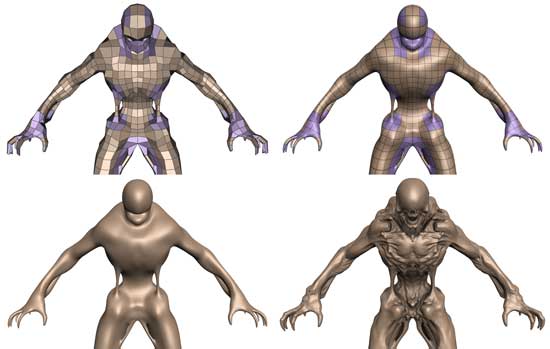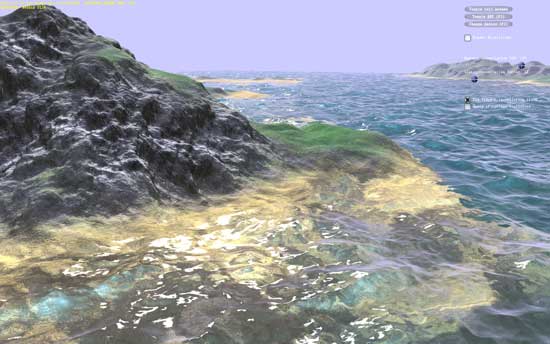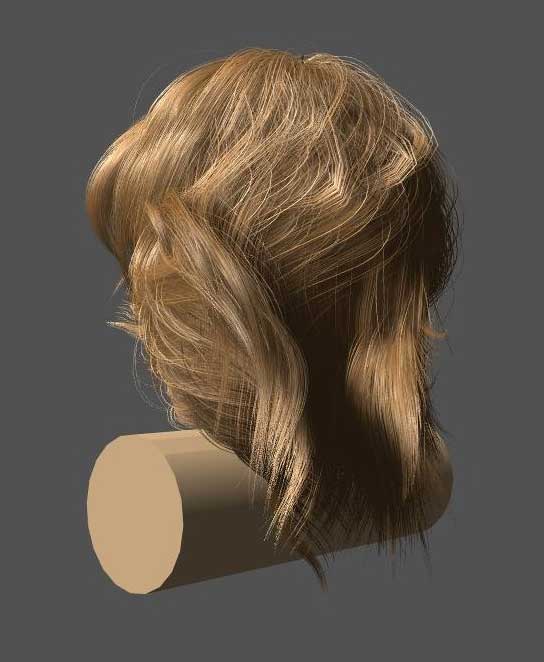Why NVIDIA Is Focused On Geometry
Up until now we haven’t talked a great deal about the performance of GF100, and to some extent we still can’t. We don’t know the final clock speeds of the shipping cards, so we don’t know exactly what the card will be like. But what we can talk about is why NVIDIA made the decisions they did: why they went for the parallel PolyMorph and Raster Engines.
The DX11 specification doesn’t leave NVIDIA with a ton of room to add new features. Without the capsbits, NVIDIA can’t put new features on their hardware and easily expose them, nor would they want to at risk of having those features (and hence die space) go unused. DX11 rigidly says what features a compliant video card should offer, and leaves you very little room to deviate.
So NVIDIA has taken a bit of a gamble. There’s no single wonder-feature in the hardware that immediately makes it stand out from AMD’s hardware – NVIDIA has post-rendering features such as 3D Vision or compute features such as PhysX, but when it comes to rendering they can only do what AMD does.
But the DX11 specification doesn’t say how quickly you have to do it.

Tessellation in action
To differentiate themselves from AMD, NVIDIA is taking the tessellator and driving it for all its worth. While AMD merely has a tessellator, NVIDIA is counting on the tessellator in their PolyMorph Engine to give them a noticeable graphical advantage over AMD.
To put things in perspective, between NV30 (GeForce FX 5800) and GT200 (GeForce GTX 280), the geometry performance of NVIDIA’s hardware only increases roughly 3x in performance. Meanwhile the shader performance of their cards increased by over 150x. Compared just to GT200, GF100 has 8x the geometry performance of GT200, and NVIDIA tells us this is something they have measured in their labs.
So why does NVIDIA want so much geometry performance? Because with tessellation, it allows them to take the same assets from the same games as AMD and generate something that will look better. With more geometry power, NVIDIA can use tessellation and displacement mapping to generate more complex characters, objects, and scenery than AMD can at the same level of performance. And this is why NVIDIA has 16 PolyMorph Engines and 4 Raster Engines, because they need a lot of hardware to generate and process that much geometry.
NVIDIA believes their strategy will work, and if geometry performance is as good as they say it is, then we can see why they feel this way. Game art is usually created at far higher levels of detail than what eventually ends up being shipped, and with tessellation there’s no reason why a tessellated and displacement mapped representation of that high quality art can’t come with the game. Developers can use tessellation to scale down to whatever the hardware can do, and in NVIDIA’s world they won’t have to scale it down very far to meet up with the GF100.
At this point tessellation is a message that’s much more for developers than it is consumers. As DX11 is required to take advantage of tessellation, only a few games exist while plenty more are on the way. NVIDIA needs to convince developers to ship their art with detailed enough displacement maps to match GF100’s capabilities, and while that isn’t too hard, it’s also not a walk in the park. To that extent they’re also extolling the other virtues of tessellation, such as the ability to do higher quality animations by only needing to animate the control points of a model, and letting tessellation take care of the rest. A lot of the success of the GF100 architecture is going to ride on how developers respond to this, so it’s going to be something worth keeping an eye on.

NVIDIA's water tessellation demo

NVIDIA's hair tessellation demo










115 Comments
View All Comments
Ryan Smith - Wednesday, January 20, 2010 - link
From my perspective, unless they can deliver better than 5870 performance at a reasonable price, then their image quality improvements aren't going to be enough to seal the deal. If they can meet those two factors however, then yes, image quality needs to be factored in to some degree.At this point I'm not sure where that would be, and part of that is diminishing returns. Tessellation will return better models, but adding polygons will result in diminishing returns. We're going to have to see what games do in order to see if the extra geometry that GF100 is supposed to be able to generate can really result in a noticeable difference.
Will game makers take advantage of it? That's the million-dollar question right now. NVIDIA is counting on them doing so, but it remains to be seen just how many devs are going to make meaningful use of tessellation (beyond just n-patching things for better curves), since DX11 game development is so young.
Consoles certainly have a lot to do with it. One very real possibility is that the bulk of games continue to be at the DX9 level until the next generation of consoles hits with DX11-like GPUs. I'll answer the rest of this in your next question.
The good news is that it takes very little work. Game assets are almost always designed at a much greater level of detail than what they ship at. The textbook example is Doom3, where the models were designed on the order of 1mil polygons; they needed to be designed that detailed in order to compute proper bump maps and parallax maps. Tessellation and the displacement map is just one more derived map in that regard - for the most part you only need to export an appropriate displacement map from your original assets, and NV is counting on this.
The only downsides to NV's plan are that: 1) Not everything is done at this high of a detail level (models are usually highly detailed, the world geometry not so much), and 2) Higher quality displacement maps aren't "free". Since a game will have multiple displacement maps (you have to MIP-chain them just like you do any other kind of map), a dev is basically looking at needing to include at least 1 more level that's even bigger than the others. Conceivably, not everyone is going to have extra disc space to spend on such assets. Although most games currently still have space to spare on a DVD-9, so I can't quantify how much of a problem that might be.
FITCamaro - Monday, January 18, 2010 - link
It will be fast. But from the size of it, its going to be expensive as hell.I question how much success nvidia will have with yet another fast but hot and expensive card. Especially with the entire world in recession.
beginner99 - Monday, January 18, 2010 - link
Sounds nice but I doubt it's useful yet. DX11, probably takes at least 1-2 year till it takes off and the geometry power could be useful. Meaning could have easly waited a generation longer.Power consumption will probably be deciding. The new Radeons do rather well in that area.
But anyway, i'm gonna wait. unless it is complete crap, it will at least help for Radeon prices going south, even if you don't buy one.
just4U - Monday, January 18, 2010 - link
On Amd pricing. It seems pretty fair for the 57XX line. Cheaper overall then the 4850 and 4870 on their launches with similiar performance and added DX11 features.It would be nice to see the 5850 and 5870 priced about one third cheaper.. but here in Canada the cards are always sold out or of very limited stock so... I guess there is some justification for the higher pricing.
I still can't get a 275 cheap either. It's priced 30-40% higher then the 4870.
The only card(s) I've purchased so far are the 5750s as I feel the last gen products are still viable at their current pricing ... and I buy a fair amount of video cards (20-100 per year)
solgae1784 - Monday, January 18, 2010 - link
Let's just hope this GF100 doesn't become another disaster that was "Geforce FX".setzer - Monday, January 18, 2010 - link
While on paper these specs look great for the High-End market (>500€ cards) how much will the mainstream market lose, as in the cards that sell around the 150~300€ bracket, which coincidently are the cards the most people tend to buy. Nvidia tends to scale down the specifications but how much will it be scaled down, what is the interest of the new IQ improvements if you can only use them on high-end cards because the mainstream cards can't handle it.The 5 series radeons are similar, the new generation only has appeal if you go for the 58xx++ cards, which are overpriced, if you already have a 4850 you can hold out from buying a new card for at least one extra year, take the 5670, it has dx11 support but hasn't the horse power to use it effectively neutering the card from start as far as dx11 goes.
So even if Nvidia goes with a March launch of GF100, I'm guessing it will not be until June or July that we see the GeForce 10600GT (like or GX600GT, phun on ATI 10000 series :P), which will just have the effect of Radeon prices to stay where they are (high) and not where they should be in terms of performance (slightly on par with the HD 4000 series).
Beno - Monday, January 18, 2010 - link
page 2 isnt workingZool - Monday, January 18, 2010 - link
It will be interesting how much of the geometry performance will be true in the end from all these hype. I wouldnt put my hand into fire on nvidias pr slides and in house demos. Like the pr graph with 600% teselation performance increase over ati card. It will surely have some dark sides too like everything around. Nothing is free. Until real benchmarks u cant trust too much to pr graphs these days.haplo602 - Monday, January 18, 2010 - link
This looks similar to what Riva TNT used to be. Nvidia was promising everything including a cure for cancer. It turned out to be barely better than 3Dfx at that time because of clock/power/heat problems.Seems Fermi will be a big bang in workstation/HPC markets. Gaming not so much.
DominionSeraph - Monday, January 18, 2010 - link
Anyone with at least half a brain had a TNT. Tech noobs saw "Voodoo" and went with the gimped Banshee, and those with money to burn threw in dual Voodoo 2's.How does this at all compare to Fermi, whose performance will almost certainly not justify its price. The 5870's doesn't, not with the 5850 in town. Such is the nature of the bleeding edge.
Do you just type things out at random?